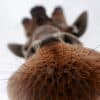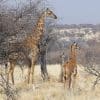New Genomic Level Analysis Confirms Four Species of Giraffe and a Need to Prioritise Their Conservation
New findings reported today in the peer-reviewed publication, Current Biology, make a strong case for recognising four distinct giraffe species. This is a major step in protecting each species, some of which are under severe threat in the wild.
A consensus on the number of giraffe species was paramount in correctly assessing their individual conservation status and afford each species adequate protection based on their level of threat on the IUCN Red List.
Until recently, giraffe were widely recognised as one single species with several subspecies. In 2016, the collaborative research of GCF, Senckenberg Biodiversity and Climate Research Centre and partners suggested otherwise by first introducing the concept for four distinct species of giraffe. This new taxonomy is now further supported by the most inclusive genomic level analysis of giraffe relationships, which clearly confirms that there are indeed four species of giraffe.
Our latest estimates show that there are only 117,000 giraffe remaining in the wild throughout Africa. This leaves only one giraffe for every four African elephant in the wild. Giraffe numbers have dropped by almost 30% over the last three decades as a result of habitat loss and fragmentation, poaching, disease, civil war and climate change. However, it is important to note that numbers vary greatly between the four species as does the level of threat they are facing. To put it simply: some giraffe species are in serious trouble while others are doing relatively well.
The research group has collaboratively analysed giraffe genetics for more than a decade; initially, to find out how similar (or different) giraffe living in various parts of Africa were to each other.
“We were extremely surprised to find such large genetic differences in giraffe in our initial study as their morphological and coat pattern differences appear limited,” says Dr Axel Janke, a geneticist at the Senckenberg Biodiversity and Climate Research Centre and Goethe University in Germany. “However, to put our results into perspective, the genetic differences between the distinct giraffe species are similar to those between polar and brown bears.”
In the new study, the collaborative research team which included other experts from the Smithsonian Conservation Biology Institute, Chinese Academy of Sciences and ITMO University, examined the genomic evidence taken from skin biopsies of a subset of >1,000 giraffe collected by GCF and its partners all throughout Africa over the last two decades. The extensive sampling includes populations from all nine previously recognized giraffe subspecies, including remote locations and areas of civil unrest.
The new analysis confirms four highly distinct groups of giraffe, which seemingly do not mate with each other in the wild. Those four species include (1) Masai giraffe (Giraffa tippelskirchi), (2) northern giraffe (Giraffa camelopardalis), (3) reticulated giraffe (Giraffa reticulata), and (4) southern giraffe (Giraffa giraffa). Both southern and northern giraffe have two and three distinct subspecies respectively: Angolan (G. g. angolensis) and South African giraffe (G. g. giraffa) for southern giraffe, and Kordofan (G. c. antiquorum), Nubian (G. c. camelopardalis) and West African giraffe (G. c. peralta) for northern giraffe. Furthermore, it is likely that Zambia’s Luangwa giraffe is a subspecies of the Masai giraffe. A more detailed analysis is still required along with other Masai giraffe across their range in East Africa.
The first-ever high-quality genome assembly of the critically endangered Kordofan giraffe (G. c. antiquorum) and a comprehensive whole-genome analysis of 50 giraffe individuals from all previously recognised subspecies were developed as part of this innovative study. Population structure and phylogenomic analyses identified that the four separately evolving giraffe lineages diverged 230,000-370,000 years ago.
The researchers stress that the results have significant conservation implications, noting that similar to the recent IUCN Red List announcement of two species of African elephant, it is important that giraffe get assessed separately for each species. Giraffe as one species are currently listed as Vulnerable on the IUCN Red List, but separate assessments of each species would likely show three of the four species as Endangered or Critically Endangered.
“It is evident that four distinct species of giraffe occur from the genomic level analysis, and as such it is critical to assess conservation status of each of these species separately and capture this on the IUCN Red List,” says Dr Julian Fennessy, Director of the Giraffe Conservation Foundation. “At the Giraffe Conservation Foundation, we see our key role in acting as a catalyst to increase giraffe conservation efforts by working collaboratively with African governments, NGOs and other partners. Using the best science available, we provide targeted support to increase education, awareness and management approaches to support giraffe conservation and protection.”
“We estimate that there are less than 6,000 northern giraffe remaining in the wild. Their numbers have declined by more than 90% in the last 35 years. As a species, they are one of the most threatened large mammals in the world and we need to urgently increase our protection efforts of this species before it is too late. The conservation implications of this genetic research are immense, and it would be ignorant to ignore these new findings. It’s time to act now!” says Dr Fennessy.
“Giraffe are assumed to have similar ecological requirements across their range”, he adds, “but no one really knows, because this megafauna has been largely overlooked by science. More conservation research is urgently needed to help us understand more about giraffe ecology across their range.”
In addition to this foundational work, the Giraffe Conservation Foundation has monitored giraffe populations and their threats throughout Africa for more than a decade. GCF works on, manages, and supports giraffe conservation initiatives that concern all four species of giraffe in 16 African countries affecting more than 100 million acres of giraffe habitat.
The full paper is available online: Raphael T. F. Coimbra, Sven Winter, Vikas Kumar, Klaus-Peter Koepfli, Rebecca M. Gooley, Pavel Dobrynin, Julian Fennessy, Axel Janke. 2021. Whole-genome analysis of giraffe supports four distinct species. Current Biology. https://doi.org/10.1016/j.cub.2021.04.033








I wanted to support by buying products as we visited the Giraffe Conservation Society. Really disappointed you don’t ship to Australia!
Hi Rosemary, we are very sorry to disappoint you. Our main priority is saving giraffe in Africa. We love that people wear their support for GCF, but shipping to some countries is too complex for us to deal with.